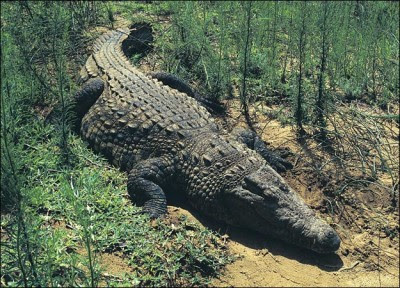
Crocodiles are large aquatic mammals that can be found throughout the tropical world. Crocodiles have been around for 200 million years and changed very little during this time. They survived the mass extinction that killed the dinosaurs and are today found in Africa, Asia, Australia and the Americas. Crocodiles are primarily found in freshwater but some species can also be found in brackish water. The saltwater crocodile (Crocodylus porosus) can wander into marine environments but is also usually found in fresh or brackish water.
Different crocodile species differs in length from 1 m / 3.3 ft to almost 9 m / 30 ft. The smallest crocodile species are the ones found in the genera Palaeosuchus and Osteolaemus which grow to 100-150 cm / 3.3-5 ft in length. The largest species of crocodile in the world is the Saltwater crocodile. The largest recorded specimen of this species was 8.6 m (28 ft) and weighed 1,352 kg (2,980 lbs). That is however a rare case and 5 m / 16 ft and 1,200 kg (2,600 lb) is to be considered more normal, although some specimens do grow considerably larger as the earlier mentioned example demonstrates. The saltwater crocodile is also the most well known of all crocodiles and when people think about crocodiles they usually think of Saltwater or Nile crocodiles (Crocodylus niloticus). It is unknown how old crocodiles can become but we do know that they can exceed 100 years of age. A freshwater crocodile in captivity in Australia is estimated to be 130 years old.
Crocodiles are ambush hunters that eat fish, birds, reptiles and mammals as well as invertebrates. Large crocodiles are even known to eat sharks, and they will certainly not hesitate to prey on smaller members of their own species. The diet varies a little between species but all crocodiles are predatory. They are “cold blooded” like all reptiles which allow them to survive long periods without food. This means that they seldom need to actively hunt and instead can be opportunistic. Large crocodile species swallow stones and the exact purpose of this remains a mystery. Some believe it is to help digest the food while others believe they are used as ballast to help the crocodile keep its balance.
Most crocodile species belong to the genus Crocodylus but some species are found outside this genus. The taxonomy of crocodiles is under review and changes might be made to this classification soon. One such change is that the Slender-snouted crocodile might be moved to its own genus, Mecistops,due to findings discovered through DNA analysis.








